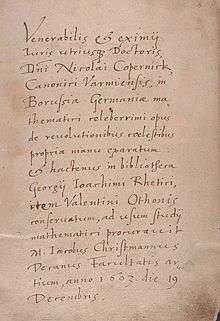Jakob Christmann
Jakob Christmann (born November 1554 in Johannisberg (Rheingau), Geisenheim – 16 June 1613 in Heidelberg) was a German Orientalist who also studied problems of astronomy.

Life

Christmann, a Jew who converted before 1578 to Christianity, studied Orientalistics at the University of Heidelberg's Collegium Sapientiae and became teacher at the Dionysianum. He followed humanist Thomas Erastus to Basel and continued his study tour in Breslau, Vienna and Prague.
In 1578, Pfalzgraf John Casimir founded the Reformed Casmirianum at Neustadt an der Haardt. Christmann joined the Casimirianum faculty in 1582 and dedicated his Arabic language Grammar, Alphabetum arabicum, to his colleagues there.
After the return of the Reformed faith to the Electorate of the Palatinate, Christmann returned to Heidelberg to serve on the faculty of the Collegium Sapientiae in 1584. After some internal debate about the location of the chair, Christmann was appointed professor of Hebrew at the university in 1585. He compiled a catalog of the manuscripts of Guillaume Postel (1510–1581), located since 1551 at Heidelberg Castle. In 1590 he published a Latin translation of the astronomy of Al-Farghani. In 1609 at the urging of Elector Frederick IV, he was appointed Europe's second professor for the Arabic language.[1]
Copernicus manuscript
A De revolutionibus manuscript of Nicolaus Copernicus passed[2] via Rheticus to others and was marked on 16 December 1603 by Christmann with Nicolai Copernick Canonici Varmiensis in Borussia Germaniae mathematici … ("of Canon Nicolaus Copernick from Warmia in Prussia of Germany, of the mathematician …").[3] Since 1953 it is located in Cracow in the Jagiellonian library (Signatur: Ms. BJ. 10 000) and is accessible online.
References
- Hockey, Thomas (2009). The Biographical Encyclopedia of Astronomers. Springer Publishing. ISBN 978-0-387-31022-0. Retrieved August 22, 2012.
- The original autograph, an intermediate between a rough copy and a fair copy, passed after Copernicus' death in 1543 to his friend Tiedemann Giese (1480–1550) and then to Georg Joachim Rheticus (1514–1574), Copernicus' only pupil, who had used a copy to publish De revolutionibus in Nuremberg in 1543. Rheticus took it to Leipzig and Cracow (1554–1574) and to Košice (Kaschau), where he died and left it to his pupil and colleague Valentin Otho (1545–1603), who took it to Heidelberg, where Jakob Christmann (1554-1613) added his remark. From his widow the manuscript was sold on 17 January 1614 to Comenius (1592–1670), who left a remark "Archived copy". Archived from the original on 2011-05-25. Retrieved 2007-11-27.CS1 maint: archived copy as title (link) signed as Johannes Amos Niuannus. On 5 October 1667 it was part of the Bibliotheca Maioratus Familiae Nostitizianae' (1608-1664) library at Jauer in Silesia, Otto von Nostitz left his signature "Archived copy". Archived from the original on 2011-05-25. Retrieved 2007-11-27.CS1 maint: archived copy as title (link) on the flyleaf. The Nostitz library was then moved to Prague, where in 1945 the collection was seized by the communist government of Republic of Czechoslovakia, and made part of the National Museum (Prague). On 7 July 1956 the government of Czechoslovakia gave it as part of an exchange to their Polish comrades, and since 25 September 1956 it is at the Jagiellonian University in Cracow. It can be accessed online (Jagiellonian library). Finally, the autograph was taken care of by the university in which Nicholas Copernicus was educated and from which he received scientific foundation for his memorable work. - after "Archived copy". Archived from the original on 2012-02-08. Retrieved 2015-08-10.CS1 maint: archived copy as title (link) and after Marian Zwiercan: The History of Nicholas Copernicus' Autograph - "Archived copy". Archived from the original on 2005-02-28. Retrieved 2007-11-27.CS1 maint: archived copy as title (link)
- Venerabilis et eximii iuris utriusque doctoris, Dni Nicolai Copernick Canonici Varmiensis in Borussia Germaniae mathematici celeberimi opus de revolutionibus coelestibus propria manu exparatum et haectenus in biblioteca Georgii Ioachimii Rhetici item Valentini Othonis conferuatum, ad usum studii mathematici procurauit M. Iakobus Christmannus Decanus Facultatis artium, anno 1603, die 19 Decembris "Archived copy". Archived from the original on 2011-05-25. Retrieved 2007-11-27.CS1 maint: archived copy as title (link) "Archived copy". Archived from the original on 2011-06-07. Retrieved 2013-01-07.CS1 maint: archived copy as title (link)
Work
- Alphabetum Arabicum cum isagoge Arabice legendi ac scribendi, Neustadt 1582
- Muhammedis Alfraganii Arabis chronologia et astronomiae elementa, Frankfurt 1590